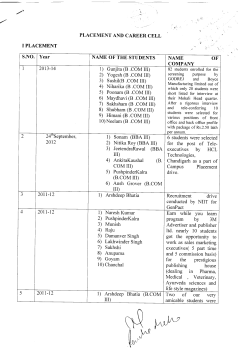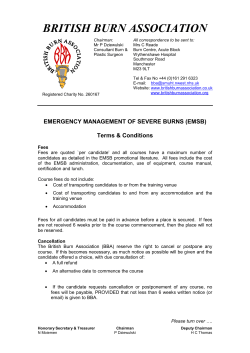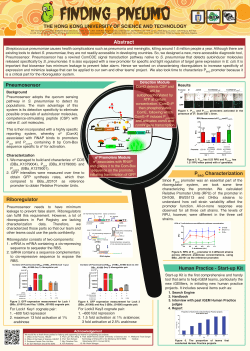
Global Connections - New America Foundation
Global Connections January 21, 2015 Objects in Motion Stay in Motion – Or Do They? 2015 has started off right where 2014 ended – with a tricky state of affairs for those in the investing business. Trends have extended – good for trend followers, worrisome for most of the rest. Questions abound and answers are few; I have some thoughts, how ‘bout you? It’s almost been enough to drive one batty, as evident from the ditty above. Nonetheless, I do have some (hopefully coherent) thoughts on the current state of play. Objects in Motion Year V Issue #169 Itaú Global Connections presents independent perspectives on economic issues and market forces that affect your current investments and strategies for the future. Newton’s First Law of Physics states that objects in motion stay in motion in the same direction unless acted upon by an unbalanced force. Objects in motion include oil, rates, inflation and the USD, among others. Each has the ability to influence portfolios and is worth consideration, given that unbalanced forces are hard to identify. Oil’s price collapse has been the object of much attention. The plunge has been relentless and has left many analysts and investors far behind – those printing amidst the deluge now see USD 40 oil as a likely resting spot (i.e., roughly 15%-20% from current prices). The bigger question is what happens then? Does oil enjoy a V-shaped recovery, as history suggests, or will it bounce along those levels for some time? Expect the latter, given the weak demand, with even China (2014 oil imports up 10%) likely to be less robust in 2015. The supply side seems unlikely to help, as all of the major producers, ex Saudi Arabia, have to pump – be it Russia, with record production in December; Nigeria, facing elections amidst a falling currency; Venezuela, post President Maduro’s tin cup tour; and even the U.S., where forecasts suggest a 6%-8% production increase as cash-flow needs drive continued production. Another object in motion has been declining sovereign interest rates. Will they continue to fall? How low can they go? Collapsing inflation prints, another object in motion, are likely to continue falling for at least the next few quarters given oil’s pass-through effect. Negative CPI prints are likely throughout Europe and the U.S. in the first half of the year, suggesting that sovereign rates, assisted by reduced supply (Q1 EU net sovereign issuance likely to be at a 5-year low), could also continue to rally. The rising USD has been another object in motion – will it continue? Anticipated ECB QE and the Swiss National Bank’s (SNB) recent decision to lift the Swiss franc cap has certainly given the dollar a boost; longterm charts suggest the dollar could be just getting started. Yet, falling oil prices may make it harder for the USD to continue strengthening against the yen and the euro mainly because, as big energy importers, both currencies will now be buttressed by much improved trade and current account balances. The USD has also been bolstered by expectations that the Fed will begin to raise rates. I disagree: falling oil and a strong USD = falling inflation = falling rates = less and later likelihood of Fed rate hikes. The odds of the Fed on hold into 2016 are rising, which is not necessarily a good thing, as the Fed’s ability to begin rate hikes would also suggest some confidence in returning to “normal” operating conditions. The UK continues to be the canary in the coalmine for U.S. policymakers. Forecasts a year ago suggested the BOE would be the first to hike rates, and gilt yields rose while sterling strengthened. BOE rate hike expectations have now been pushed out to 2016 – expect U.S. rate hike expectations to follow, which, together with weak oil, should be enough to cool the dollar’s ascent for a while. The UK has confronted what I have called the natural governor effect of the current geo-economic climate. The governor effect suggests that developed market economies are too weak to stomach strong currencies and high rates, particularly given their state of “chronic demand deficiency,” as the FT’s Martin Wolf puts it. The U.S. may be next. This demand weakness can be laid at the doorstep of flat real wages in the developed world for the past several years, which reinforces rising inequality (a U.S. election issue), the disinflationary environment, and the degree of difficulty CB action has had gaining traction. Please refer to page 6 of this report for important disclosures, analyst certifications and additional information. Itaú BBA does and seeks to do business with Companies covered in this research report. As a result, investors should be aware that the firm may have a conflict of interest that could affect the objectivity of this report. Investors should not consider this report as the sole factor in making their investment decision. Itaú Corretora de Valores S.A. is the securities arm of Itaú Unibanco Group. Itaú BBA is a registered mark used by Itaú Corretora de Valores S.A. Jay Pelosky is Principal of J2Z Advisory, LLC. Read this report in: 5 min: Front Page 19 min: Full Report Global Connections – January 21, 2015 Objects That May Go Into Motion What about objects that may go into motion? For example, the ECB and QE – will it finally happen? Yes is the answer, but this begs another question – will QE have any meaningful effect or did the ECB wait too long? Or perhaps the ECB is smarter than most realize and waited not because it had to, but because it wanted to. Why? Because what if the European economy is actually bottoming and QE is meant to buttress a modest but real recovery spurred by euro weakness (IP is up for the past 3 months, M1 growth is strong), some consumer demand (record-low Germany UER, rising EU retail sales) and an infrastructure investment program. What if? Another object that may go into motion is more worrisome, and that is the prospect for China’s RMB to weaken over the course of 2015 (see 2015 Outlook – Tough Choices Ahead, published December 2, 2014). The U.S. and China have been the main sources of global credit stimulus since 2009. Recently both have been pulling back, with the Fed ending QE and China trying to rein in credit demand. The 2015 version of credit stimulus is the willingness of both the U.S. and China to allow other countries to undercut them in global markets via currency depreciation. The USD strength is well known, but few appreciate that the RMB fell by only 2% versus the USD in 2014, versus a broad EM FX index falling 12% and the yen and euro falling appreciably more. 2015 Tail Risk Update China suffers from very low inflation in CPI terms (currently at 1.5%) and has suffered from deflation in PPI terms for several years. December’s PPI reading was -3.3%, a record low symbolic of the pressures facing China’s producers. Should China decide to help this segment of its economy (an important source of labor demand), a controlled 10%-15% depreciation of the RMB could be on the cards. This could send another deflationary wave into the global economy, via the manufacturing space, amid further currency declines in the rest of Asia as it tries to stay abreast of the China price. This scenario is the top geo-economic tail risk for 2015. Another tail risk is the economic soufflé argument, where the global economy sinks under a negative surprise such as a much weaker-thanexpected U.S. economy, a European recession or Chinese growth shortfall. The third tail risk highlighted in the 2015 Outlook focused on a U.S. economic upside surprise, creating fear that the Fed was behind the curve and leading to a rate spike. Recent events suggest the risk of such a scenario playing out has declined. One nagging worry is the prospect of markets losing faith in Central Banks’ (CB) ability to influence events as sovereign rates approach zero and even go negative. The Swiss National Bank’s (SNB) recent move suggests CB policy may already be shifting from QE/zero rate to negative rate policy as investors pay up for safety (the cost of negative rates) to protect against the risk of larger losses (see Every Country for Itself, published May 30, 2014). Markets are awash in capital, yet thirsting for liquidity. Should a loss of faith occur, risk assets could sell off at a time when monetary authorities have exhausted much of their ammo. With more and more of the DM sovereign-bond market trading at negative rates, the end game of this policy mix seems well worth thinking through. Objects in Motion – Takeaways Oil Price – V-Shaped Recovery Unlikely Global Inflation – Continue Lower Global Rates – Remain Under Downward Pressure USD – Ready for a Rest Deflation Risk – Rising Itaú BBA 2 Global Connections – January 21, 2015 Portfolio Considerations & Implications Our focus lies at the intersection of global economics, policy and portfolio construction. The geoeconomic and policy context has been laid out – what about the portfolio implications? The Greater the Uncertainty, the Greater the Cash Level The speed and magnitude of oil’s decline has meaningfully raised the uncertainty level. A good rule of thumb is the greater the uncertainty, the greater the cash level. Raising cash should be simple – sell whatever you don’t have very firm conviction in for an environment similar to what has been laid out above. The SNB decision reinforces this suggestion. Objects in motion tend to stay in motion – the dollar and rates were covered above – what about stocks? For the past few years, the equity decision has been made simple by the U.S. equity market’s relentless move higher, absorbing more and more interest until there is very little interest in any equity market outside the U.S. As highlighted in the 2015 Outlook piece, the question of staying long U.S. equity or moving to the nonU.S. developed markets is perhaps the equity investors’ toughest choice. From this armchair, the U.S. market’s risk-reward profile seems to be declining. It is fully priced on an absolute, and certainly on a relative, basis. It has been bolstered by stock buybacks (up 25% Y/Y in 3Q14 with an amazing USD 1.6 trillion spent since 2011), has a long line of IPOs in front of it, and is priced as the best house on the block (U.S. equity outperformance widest since 2001). Thus the poor upside/downside outlook. On a go-forward basis, it’s worth considering that developed economy non-financial corporates might be about to face what investors have had to deal with for years, namely the lack of a tailwind. For investors it is the lack of returns on cash. For operating companies, it is the inability to raise prices in a disinflationary/deflationary environment. Generating sales growth, if not profits, will become much tougher in the months and quarters ahead. Given that the U.S. equity market is fully priced, and thus more dependent on earnings growth to justify rising stock prices, this may become an issue fairly quickly. As Barton Biggs used to say about beaten-down assets, news doesn’t have to get better, it just has to get less bad. Here lies the essence of the 2015 opportunity: non-U.S. DM news only has to get less bad for these markets to outperform AS LONG AS the U.S. equity market does not crash. It is hard to see the U.S. surprising on the upside in terms of economic growth, corporate earnings, etc. A crash is also hard to see given the global capital glut. Japan Japan, a huge energy importer, is a major beneficiary of USD 50 oil, which almost completely rebalances its trade profile (the inflation target is a different matter). This is one reason why yen weakness is not as necessary today as it seemed even six weeks ago. Japan, as every sentient being knows, also has a demographic problem – it is getting older and its population is shrinking. It just might be, however, that this problem is actually a near-term opportunity. Full employment in Japan is likely to lead to wage gains (watch Spring wage rounds) and thus a pickup in consumption, an earnings recovery, rising valuations and an outperforming stock market in 2015. Talk about making lemonade out of lemons! Oh, and please note that a few weeks ago close to 40% of trading volume in Japanese equity was on the short side (a record?). Don’t forget the big buyer either, as the GPIF continues to add to equities. A preholiday lunch with a senior macro trader at a top-tier U.S. investment bank yielded this nugget: No one has any interest whatsoever in anything other than U.S. equities. Now while that may be a bit of an exaggeration, it is not too far off the mark with the short position in Japan (as noted above) and the near wholesale selloff of European equities in the past month or so. Even the potential success stories like Spain are down roughly 20% in USD terms; and the banks (a favored sector), likewise round-tripping and back to 2011-12 levels, even with cleaner balance sheets (2014 loan portfolio sales up 133%), stronger capital levels (highest debt sales since 2007) and the near certainty that the ECB will engage in QE at month’s end. Itaú BBA 3 Global Connections – January 21, 2015 The Surprise of 2015 Many U.S. equity investors focus on the first part of January to get a sense of how the market is likely to do for the full year. Right now it does not look good. If investors conclude that the U.S. has limited upside and the news gets a little less bad in Japan and in Europe, then watch out for the surprise of 2015…U.S. equity underperformance. The U.S. market looks like a crowded trade and yet not a single Wall St. strategist has the S&P ending 2015 with negative full-year returns. While this is not a huge surprise, given the six up years in a row and double-digit returns in each of the last three years; I think a plus or minus 5% S&P 2015 return is very doable, and, if so, expect the non-U.S. DM, namely Japan and Europe but perhaps also the UK, to outperform. The 2014 surprise was that long duration debt did really well (see 2014 & the Fight Against Deflation, published November 25, 2013). 2015’s surprise could well be non-U.S. DM equity market outperformance. The additional surprise might be that they do so in local currency as well as on a USD basis. Put cash to work in these markets, split between hedged and un-hedged vehicles. Fixed Income On the fixed income side, the good news is that rate spike risk (the bête noire of the markets) has been taken out of 2015’s calculus via the oil shock. The bad news is that last year’s huge rally in sovereign and high-quality corporate credit has taken away a lot of upside. UST continue to look attractive on a relative basis (10-year UST yield @ 1.74% versus 0.30% in Germany and 0.20% in Japan), while deflation risk and reduced supply support sovereigns in Europe and Japan. With QE likely in Europe and continuing in Japan, it is hard to see rates backing up in any meaningful way. Adding to long duration UST on pullbacks makes sense. U.S. preferreds are a top fixed income choice for this year, many of which yield 6% or better, pay monthly and have very supportive charts. US MBS and HY are also attractive, though the fall in rates has increased the refinancing risk for MBS. US HY now yields over 7%, while the energy risk has been pretty well captured and the space trades better than it has in months. One has to always ask what is in the price, and here it seems like much of the downside has been priced in. Non-traditional yield plays such as infrastructure and real estate remain of interest. Emerging Markets What about Emerging Markets? Mexico remains the favored equity destination. A cheap peso, down close to 15% versus the dollar, a stock market that is more fairly valued given a similar 15% decline, an economy that is becoming more and more integrated with its northern neighbor, and an energy sector that will open as the year progresses, are all supportive. It’s also worth noting that while Mexico as a crude exporter has hedged 2015 sales at a price some 50% above spot, it also imports refined products that will now be much cheaper. India is also becoming more attractive as weak oil leads to inflation declines, which allow for rate cuts – valuation remains challenging, as does execution risk in terms of government policy. USD-denominated sovereign EM debt remains attractive. Default risk exists (Venezuela, Ukraine), but seems priced in together with corporate default risk and compensated with a 6% yield. The technical picture is also supportive, with 2015 sovereign net issuance back to 2008 levels. Finally, in discussing objects in motion, one might consider energy-related yield plays. Vehicles with hedged production and yields that are not completely at risk of being eliminated could do well. These assets seem to be stabilizing ahead of the oil price. Yours truly is in the space, sizing properly (one hopes) and being more trading-driven than usual. One thing is for certain, while another name for Newton’s First Law is the “Law of Inertia”, investors cannot afford to be inert in 2015…stay focused, my friends! Itaú BBA 4 Global Connections – January 21, 2015 Jay Pelosky is Principal of J2Z Advisory, LLC, a global asset allocation and portfolio strategy consultancy for institutional investors. Jay advises clients and invests personally based on insights gained from 30 years of financial market experience in over 45 countries. For the past decade, he has invested his own capital in a global, multi-asset, ETF-based Asset Allocation strategy. He sits on the board of Franklin Holdings (Bermuda) Ltd. and serves on the advisory board of Carmel Asset Management. Jay teaches a graduate level course, The Art and Practice of Global Investing, at The George Washington University and is a founding member of the New America Foundation’s World Economic Roundtable. His formal Wall Street career spanned twenty years and included positions on both the buy-side and sell-side. At Morgan Stanley, he launched the Firm’s global asset allocation and global equity strategy research products. He also formed and co-chaired the research department’s asset allocation committee. Jay created the firm’s Global Emerging Market Strategy (GEMS) product and initiated its equity investment, research, and strategy efforts in Latin America. jaypelosky@pelosky.com Itaú Global Connections – Recent Issues D ate 01/16/15 12/15/14 12/15/14 12/02/14 11/17/14 11/12/14 10/31/14 Issue # 168, by Stephen L. Jen Issue # 167, by Felix W. Zulauf Issue # 166, by Stephen L. Jen Issue # 165, by Jay P elo sky Issue # 164, by Stephen L. Jen Issue # 163, by Felix W. Zulauf Issue # 162, by Jay P elo sky EM ’ s B ad Case o f QE Hango ver Oil Slump P ushes M arkets Do wn a Slippery Slo pe NA FTA x 20 2015 Outlo o k – To ugh Cho ices A head M y Tho ughts o n Currencies Japan’ s Dangero us Experiment Tempest in a Tea P o t – What Do es It Tell Us? Itaú BBA 5 Global Connections – January 21, 2015 DISCLAIMER Itaú BBA is a brand name of Itaú Corretora de Valores S.A. Ratings: Definitions, Dispersion and Banking Relationships Ratings (1) Definition (2) Coverage (3) Banking Relationship (4) Outperform The analyst expects the stock to perform better than the market average. 56% 52% Market Perform The analyst expects the stock to perform in line with the market average. 35% 33% Underperform The analyst expects the stock to perform below the market average. 9% 8% 1. The ratings used herein (Outperform, Market Perform and Underperform), for purposes of the ratings distribution disclosure requirements of FINRA and the NYSE, correspond most closely, respectively, to Buy, Hold and Sell. 2. Ratings reflect the analyst’s assessment of the stock price performance in the medium term compared with the market average. Recommendations will be valid until the analyst changes the rating, which may happen as a result of news or simply due to a change in the stock price (there is not a defined time horizon). Companies are grouped, according to their similarities, into sectors. The sectors are: (i) Banking & Financial Services, (ii) Consumer Goods & Retail + Food & Beverage, (iii) Healthcare + Education, (iv) Steel & Mining + Pulp & Paper, (v) Oil, Gas & Petrochemicals + Agribusiness, (vi) Real Estate, (vii) Telecommunications, Media and Technology, (viii) Transportation, Industrials and Logistics, (ix) Utilities, and (x) Equity Strategy. 3. Percentage of companies under coverage by Itaú Corretora de Valores S.A. within this rating category. 4. Percentage of companies within this rating category for which Itaú Unibanco S.A. or any of its affiliated companies provided investment banking services within the past 12 (twelve) months, or may provide investment banking services during the next 3 (three) months. Relevant Information 1. This report has been prepared by Mr. Jay Pelosky as a consultant to Itaú Corretora de Valores S.A (“Itaú BBA”), a subsidiary of Itaú Unibanco S.A., and distributed by Itaú BBA or one of its affiliates (altogether, “Itaú Unibanco Group”). Itaú BBA is the brand name used by Itaú Corretora de Valores S.A., by its affiliated or by other companies of the Itaú Unibanco Group. . This report is being distributed (i) in the United States by Itaú BBA USA Securities Inc., a FINRA/SIPC member firm; (ii) in the United Kingdom and Europe by Itau BBA UK Securities Limited, regulated by the Financial Services Authority (FSA). Details about the extent of its authorization and regulation by the FSA are available on request; and (iii) in Hong Kong by Itaú Asia Securities Limited, licensed in Hong Kong by the Securities and Futures Commission for Type 1 (dealing in securities) regulated activity (altogether, “Itaú Group”). This report is provided for informational purposes only and does not constitute or should not be construed as an offer to buy or sell or solicitation of an offer to buy or sell any financial instrument or to participate in any particular trading strategy in any jurisdiction. The information herein is believed to be reliable as of the date in which this report was issued and has been obtained from public sources believed to be reliable. Itaú Group does not make any representation or warranty, express or implied, as to the completeness, reliability or accuracy of such information, nor is this report intended to be a complete statement or summary of the securities, markets or developments referred to herein. Opinions, estimates, and projections expressed herein constitute the current judgment of the analyst responsible for the substance of this report as of the date in which it report was issued and are therefore subject to change without notice. Prices and availability of financial instruments are indicative only and subject to change without notice. Itaú Group has no obligation to update, modify or amend this report and inform the reader accordingly, except when terminating coverage of the issuer of the securities discussed in this report. 2. This report has been prepared by Mr. Jay Pelosky, who hereby certifies that the views expressed herein accurately and exclusively reflect his personal views and opinions about any and all of the subject matter discussed and that this report was prepared by Mr. Pelosky independently and autonomously, including from Itaú BBA. The views expressed herein do not necessarily reflect the views of Itaú BBA, its subsidiaries and affiliates. Because personal views of analysts may differ from one another, Itaú BBA, its subsidiaries and affiliates may have issued or may issue reports that are inconsistent with, and/or reach different conclusions from, the information presented herein. Mr. Pelosky is not registered and/or qualified as a research analyst with the NYSE or FINRA, and is not associated with Itaú BBA USA Securities Inc. and, therefore, may not be subject to Rule 2711 restrictions on communications with a subject company, public appearances and trading securities held by a research analyst account. 3. The financial instruments discussed in this report may not be suitable for all investors. This report does not take into account the investment objectives, financial situation or particular needs of any particular investor. Investors should obtain independent financial advice based on their own particular circumstances before making an investment decision based on the information contained herein. If a financial instrument is denominated in a currency other than an investor’s currency, a change in exchange rates may adversely affect the price or value of, or the income derived from, the financial instrument, and the reader of this report assumes any currency risk. Income from financial instruments may vary and its price or value, either directly or indirectly, may rise or fall. Past performance is not necessarily indicative of future results, and no representation or warranty, express or implied, is made herein regarding future performances. Itaú Group does not accept any liability whatsoever for any direct or consequential loss arising from any use of this report or its content. 4. This report may not be reproduced or redistributed to any other person, in whole or in part, for any purpose, without the prior written consent of Itaú Corretora de Valores S.A. (“Itaú BBA”). Additional information relative to the financial instruments discussed in this report is available upon request. 5. This report may contain links to third-party websites. Itaú Corretora de Valores S.A. (“Itaú BBA”) is not responsible for the content of any third-party website or any linked content contained in a third-party website. Content contained on such thirdparty websites is not part of this report and is not incorporated by reference into this report. The inclusion of a link in this report does not imply any endorsement by or any affiliation with Itaú Corretora de Valores S.A. (“Itaú BBA”). Access to any third-party website is at your own risk, and you should always review the terms and privacy policies at third-party websites before submitting any personal information to them. Itaú Corretora de Valores S.A. (“Itaú BBA”) is not responsible for such terms and privacy policies and expressly disclaims any liability for them. Itaú BBA 6 Global Connections – January 21, 2015 Additional Note to reports distributed in: (i) U.K. and Europe: Itau BBA International plc: This material is distributed and authorized by Itau BBA International plc (IBBA UK) pursuant to Section 21 of the Financial Services and Markets Act 2000. The material describing the services and products offered by Itaú Unibanco S.A. (Itaú) has been prepared by that entity. IBBA UK is a subsidiary of Itaú. Itaú is a financial institution validly existent under the laws of Brazil and a member of the Itaú Unibanco Group. Itau BBA International plc registered office is The Broadgate Tower, level 20, 20 Primrose Street, London, United Kingdom, EC2A 2EW and is authorised by the Prudential Regulation Authority and regulated by the Financial Conduct Authority and the Prudential Regulation Authority (FRN 575225). Itau BBA International plc Lisbon Branch is regulated by Banco de Portugal for the conduct of business. Itau BBA International plc has representative offices i n France, Colombia, Germany, and Spain which are authorised to conduct limited activities and the business activities conducted are regulated by Banque de France, Superintendencia Financiera de Colombia, Bundesanstalt fur Finanzdienstleistungsaufsicht (BaFin), and Banco de España respectively. None of the offices and branches deal with retail clients. For any queries please contact your relationship manager. For more information go to: www.itaubba.co.uk; (ii) U.S.A: Itau BBA USA Securities, Inc., a FINRA/SIPC member firm, is distributing this report and accepts responsibility for the content of this report. Any US investor receiving this report and wishing to effect any transaction in any security discussed herein should do so with Itau BBA USA Securities, Inc. at 767 Fifth Avenue, 50th Floor, New York, NY 10153; (iii) Asia: This report is distributed in Hong Kong by Itaú Asia Securities Limited, which is licensed in Hong Kong by the Securities and Futures Commission for Type 1 (dealing in securities) regulated activity. Itaú Asia Securities Limited accepts all regulatory responsibility for the content of this report. In Hong Kong, any investors wishing to purchase or otherwise deal in the securities covered in this report should contact Itaú Asia Securities Limited at 29th Floor, Two IFC, 8 Finance Street – Central, Hong Kong; (iv) Japan: This report is distributed in Japan by Itaú Asia Securities Limited – Tokyo Branch, Registration Number (FIEO) 2154, regulated by Kanto Local Finance Bureau, Association: Japan Securities Dealers Association; (v) Middle East: This report is distributed by Itau Middle East Limited. Itau Middle East Limited is regulated by the Dubai Financial Services Authority and is located at Suite 305, Level 3, Al Fattan Currency House, Dubai International Financial Centre, PO Box 482034, Dubai, United Arab Emirates. This material is intended only for Professional Clients (as defined by the DFSA Conduct of Business module) no other persons should act upon it; (vi) Brazil: Itaú Corretora de Valores S.A., a subsidiary of Itaú Unibanco S.A authorized by the Central Bank of Brazil and approved by the Securities and Exchange Commission of Brazil, is distributing this report. If necessary, contact the Client Service Center: 4004-3131* (capital and metropolitan areas) or 0800-722-3131 (other locations) during business hours, from 9 a.m. to 8 p.m., Brasilia time. If you wish to re-evaluate the suggested solution, after utilizing such channels, please call Itaú’s Corporate Complaints Office: 0800-570-0011 (on business days from 9 a.m. to 6 p.m., Brasilia time) or write to Caixa Postal 67.600, São Paulo-SP, CEP 03162-971. * Cost of a local call. Itaú BBA 7
© Copyright 2025









